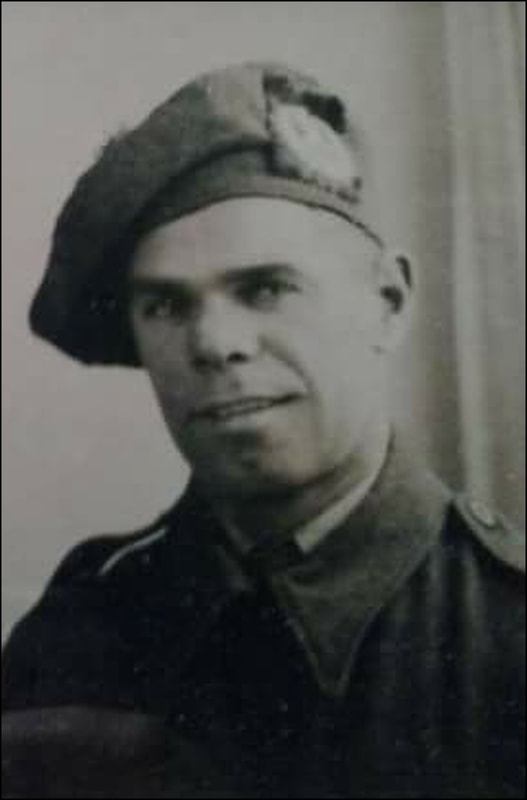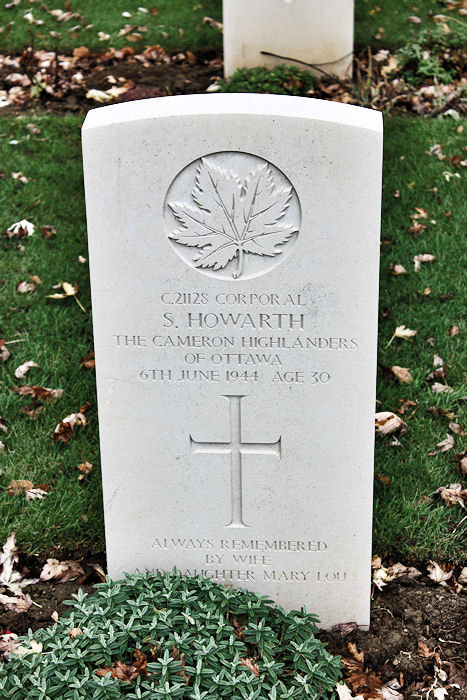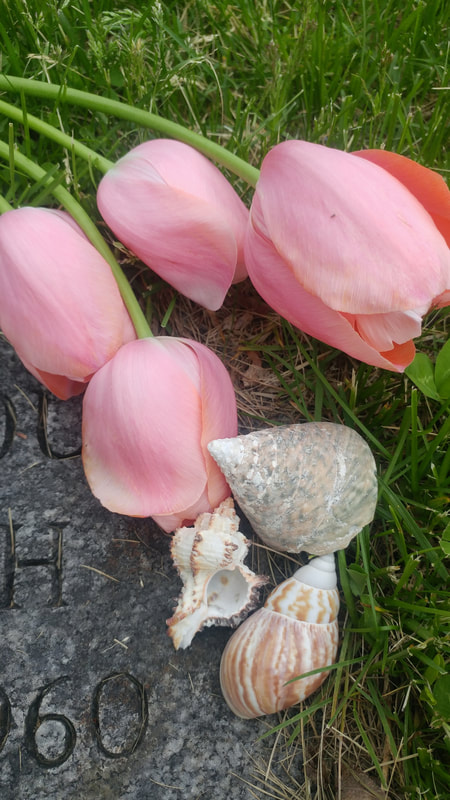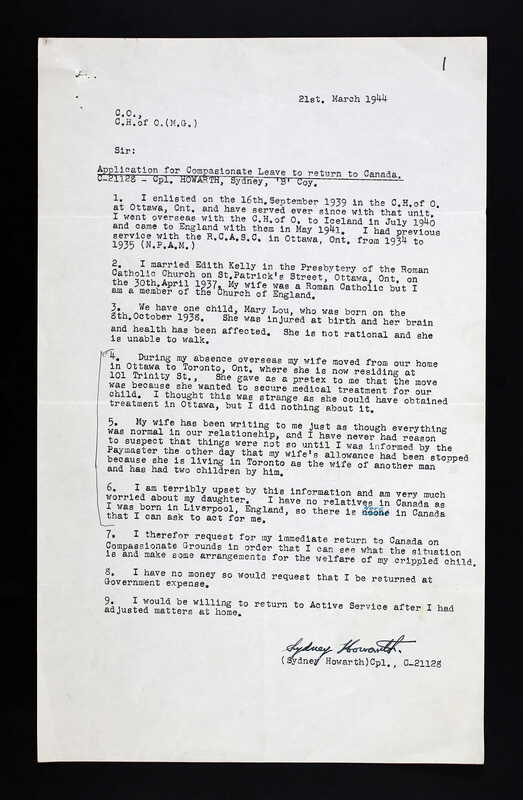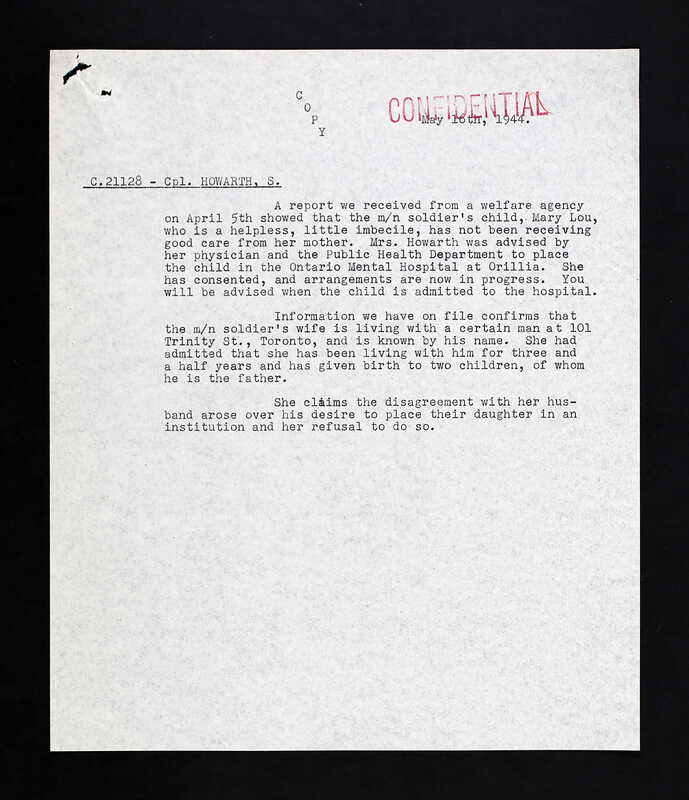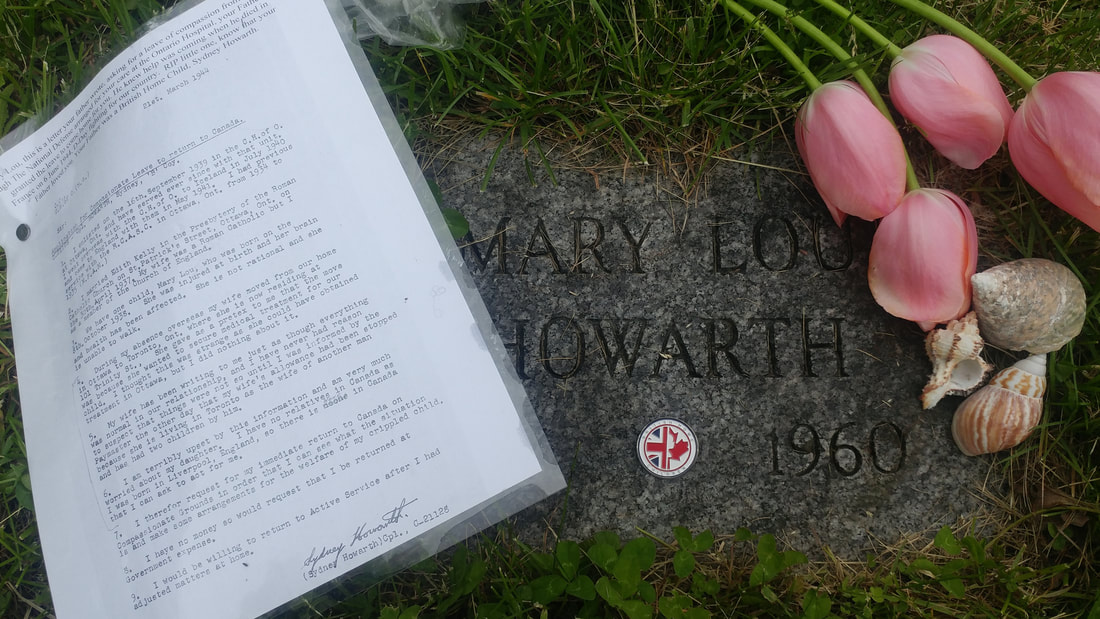The Story of Sydney Howarth and his beloved daughter Mary Lou
Researched by Lori Oschefski and Dawn Heuston, written by Lori
Sidney lost his life on June 4th 1944
|
Sydney Howarth was one of the over 110,000 children sent to Canada – between 1869 and 1948 - to work as indentured servants. He was one of the over 20,000 Home Children who served for Canada in our Wars. Sydney was one of the three-hundred-fifty-nine Canadian Soldiers who lost their lives on Juno Beach 6 June 1944. Shot through the heart, he died instantly. Almost 75 years later, to the day, letters found in Sydney’s Second World War service file uncovered the turmoil and heartache he suffered in the last few weeks before his death.
This is the story of Sydney and his daughter Mary Lou – a resident of Orillia’s Ontario Hospital Sydney was born on 19 Feb 1914 to James Howarth and his wife Ada Elizabeth Plummer. Sydney had two siblings, James Herbert – an older brother and a younger half sister Mary Sheriff. Mary was born around 1926 - she is listed on Sydney’s 1944 record of death as being eighteen years of age. The appearance of Mary suggests Ada may have become a widow and remarried, although these records have not yet been found. In 1929 Sydney emigrated to Canada through the British Immigration and Colonization Association. (BICA) BICA’s mandate was to bring British boys, from 14 to 18 to Canada to work as farm hands. The boys and their parent (s) were required to consent to emigration, which sets them slightly apart from general British Home Children (BHC), where consent was often not a consideration. Like BHC, BICA boys were not to return to England, but rather settle in Canada permanently. Wages for the boys were to be paid to BICA, with the farmers reviewing the payments with the boys – who were to sign the account documents. Boys were to receive pocket money. Unlike many BHC, BICA boys were to be kept fully aware that they were owed money for their work and how much that was plus a listing of their expenses. Sydney was first placed in Armprior, Renfrew with Mr. J. Findley. The expected rate of pay for this fifteen-year-old lad was between $120 and $150 per year. Sydney, was paid $120, the lowest amount. By September of 1931, he was moved to the farm of Mr. J. S. Harvey. Things did not work out for Sidney as he “went missing” from this farm. “Address unknown” was recorded until Sydney surfaces in June of 1932 – once again with J.S. Harvey in Armprior. Reaching the age of eighteen in 1933, Sydney was released from his indenture and expected to make his own way now in Canada. He joined The Royal Canadian Army Service Corps, serving in 1934 – 1935, following which he made his way as a “milk keeper”. Edith Margaret Ida Kelly was born and raised in Armprior. At the age of 19, this young waitress wed Sydney. The marriage was recorded 30 April 1936 in Ottawa. Their only child, a daughter Mary Lou, was born in 1937. An accident at birth rendered Mary Lou disabled. Her brain and health were damaged, and she was left unable to walk. The couple were determined to care for their child at home. It is unimaginable how difficult that would be on the wages of a milk keeper and a waitress. Sydney returned to service, enlisting on 16 September 1939, with The Cameron Highlanders of Ottawa. On 4 April 1940 he was promoted to Acting Lance Corporal (A/LC) while still training in Ottawa. Later that year he was dispatched to Iceland and in 1941, on to serve in England. Edith remained in their Ottawa home for a period, then citing the need for better medical treatment for their daughter – she moved to 101 Trinity Street, Toronto. Edith continued to correspond with her husband overseas, never once indicating anything was amiss. In an official DAB letter dated 28 Feb 1944, the decision was made to suspend Edith’s allowance as it was discovered that she was living in Toronto as the wife of another man – with whom she had two children. The dependent’s allowance was also suspended. Mid-March, Sydney was informed of this very upsetting information by the paymaster. 22 March 1944 Sydney applied for a compassion leave so that he might immediately return home to ensure Mary Lou was receiving proper care. As he explained, he was from Liverpool, England and he has absolutely no family or anyone in Canada that would be able to help ensure his daughters proper care. 4 April 1944 the Department of National Defense requested a report on Edith and Mary Lou’s care in Canada. |
A report was received the next day (forwarded to Sydney on May 16th) that Mary Lou who was a “helpless, little imbecile” was not receiving good care from her mother. Edith admitted to having lived with another man as his wife for three and a half years, literally from the time her husband was dispatched to Iceland to begin his overseas service.
he Toronto City Directory shows Edith living at 101 Trinity Street with Ernest Merpaw, a truck driver from Ottawa. Edith was advised by her physician and the Public Health Department to admit Mary Lou to the “Ontario Mental Hospital” located in Orillia, Ontario. The Ontario Hospital (Huronia Regional Center) was a large facility built to house intellectual handicap persons. Most people admitted there lived their lives out in the hospital. Mary Lou would be no exception. Although the National Defense acted on Sydney’s behalf to ensure proper care for his daughter, he was not granted a Leave of Compassion. On 3 June 1944 Sydney embarked United Kingdom for invasion to Normandy, France.
6 June 1944, during the invasion of Normandy, Sydney was shot through the heart; killed instantly. His heart which had ached so much for his daughter in his final weeks of his life, was forever stilled. His platoon officer carried his body away from his gun and covered Sydney’s face with his helmet. Orders were given for the soldiers to move forward and they did so leaving Sydney behind. 7 June 1944 he was buried South of Bernieres-sur-Mer, on the edge of the field next to a rock. Sydney never lived to hear if his daughter had been placed into care. He died in uncertainty and longing to go home to his daughter.
Edith, who continued to live with Merpaw long after her husband’s death, received Sydney’s last pay of $35.67. She also received his service medals. Mary Lou, however, received (in trust with The Public Trustee in charge of her care) his War Service Gratuity of $955.14. Mary Lou continued to live at the Ontario Hospital until her death, at 22 years old, on 21 September 1960. She is buried in the institution’s cemetery for patients who died there. Prior to 1958 patients were buried with just markers giving a number – no names were recorded on the stones. Following 1958 all patients were buried with stones indicating their name, year of birth and year of death. Therefore, Mary Lou has a proper stone. Recently monuments have been installed in the cemetery which commemorates all the people buried there. Sydney's remains were "carefully exhumed from his original grave in January of 1946, and "reverently" reburied in grave 9, row B, plot 5 of Beny-sur-Mer Canadian Military Cemetery in France.
he Toronto City Directory shows Edith living at 101 Trinity Street with Ernest Merpaw, a truck driver from Ottawa. Edith was advised by her physician and the Public Health Department to admit Mary Lou to the “Ontario Mental Hospital” located in Orillia, Ontario. The Ontario Hospital (Huronia Regional Center) was a large facility built to house intellectual handicap persons. Most people admitted there lived their lives out in the hospital. Mary Lou would be no exception. Although the National Defense acted on Sydney’s behalf to ensure proper care for his daughter, he was not granted a Leave of Compassion. On 3 June 1944 Sydney embarked United Kingdom for invasion to Normandy, France.
6 June 1944, during the invasion of Normandy, Sydney was shot through the heart; killed instantly. His heart which had ached so much for his daughter in his final weeks of his life, was forever stilled. His platoon officer carried his body away from his gun and covered Sydney’s face with his helmet. Orders were given for the soldiers to move forward and they did so leaving Sydney behind. 7 June 1944 he was buried South of Bernieres-sur-Mer, on the edge of the field next to a rock. Sydney never lived to hear if his daughter had been placed into care. He died in uncertainty and longing to go home to his daughter.
Edith, who continued to live with Merpaw long after her husband’s death, received Sydney’s last pay of $35.67. She also received his service medals. Mary Lou, however, received (in trust with The Public Trustee in charge of her care) his War Service Gratuity of $955.14. Mary Lou continued to live at the Ontario Hospital until her death, at 22 years old, on 21 September 1960. She is buried in the institution’s cemetery for patients who died there. Prior to 1958 patients were buried with just markers giving a number – no names were recorded on the stones. Following 1958 all patients were buried with stones indicating their name, year of birth and year of death. Therefore, Mary Lou has a proper stone. Recently monuments have been installed in the cemetery which commemorates all the people buried there. Sydney's remains were "carefully exhumed from his original grave in January of 1946, and "reverently" reburied in grave 9, row B, plot 5 of Beny-sur-Mer Canadian Military Cemetery in France.
